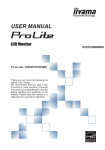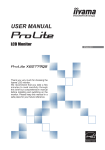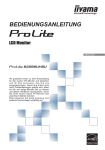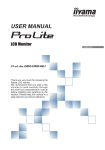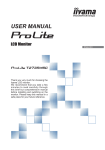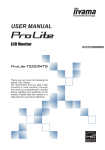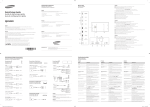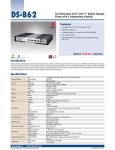Download User manual
Transcript
USER MANUAL ENGLISH Thank you very much for choosing the iiyama LCD monitor. We recommend that you take a few minutes to read carefully through this brief but comprehensive manual before installing and switching on the monitor. Please keep this manual in a safe place for your future reference. CE MARKING DECLARATION OF CONFORMITY This LCD monitor complies with the requirements of the EC/EU Directive 2004/108/EC “EMC Directive”, 2006/95/EC “Low Voltage Directive”, 2009/125/EC “ErP Directive” and 2011/65/EU “RoHS Directive”. The electro-magnetic susceptibility has been chosen at a level that gives correct operation in residential areas, business and light industrial premises and small-scale enterprises, inside as well as outside of the buildings. All places of operation are characterised by their connection to the public low voltage power supply system. ENGLISH IIYAMA CORPORATION: Wijkermeerstraat 8, 2131 HA Hoofddorp, The Netherlands We recommend recycling of used product. Please contact your dealer or iiyama service center. Recycle information is obtained via the Internet, using the address: http://www.iiyama.com You can access the Web page of different countries from there. We reserve the right to change specifications without notice. All trademarks used in this user manual are the property of their respective owners. ® ® As an ENERGY STAR Partner, iiyama has determined that this product meets the ENERGY STAR guidelines for energy efficiency. TABLE OF CONTENTS FOR YOUR SAFETY............................................................................1 SAFETY PRECAUTIONS................................................................1 SPECIAL NOTES ON LCD MONITORS .........................................3 ENGLISH CUSTOMER SERVICE ...................................................................3 CLEANING ......................................................................................3 BEFORE YOU OPERATE THE MONITOR ..........................................4 FEATURES......................................................................................4 CHECKING THE CONTENTS OF THE PACKAGE ........................4 WALL MOUNTING ..........................................................................5 FITTING AND REMOVAL OF BASE ...............................................6 CONTROLS AND CONNECTORS..................................................7 CONNECTING YOUR MONITOR ..................................................8 COMPUTER SETTING ...................................................................9 ADJUSTING THE HEIGHT AND THE VIEWING ANGLE ...............9 OPERATING THE MONITOR.............................................................10 ADJUSTMENT MENU CONTENTS .............................................. 11 SCREEN ADJUSTMENTS ............................................................19 POWER MANAGEMENT FEATURE.............................................22 TROUBLE SHOOTING ......................................................................23 RECYCLING INFORMATION.............................................................24 APPENDIX ........................................................................................25 SPECIFICATIONS .........................................................................25 DIMENSIONS................................................................................26 COMPLIANT TIMING ....................................................................26 FOR YOUR SAFETY SAFETY PRECAUTIONS WARNING If you notice any abnormal phenomena such as smoke, strange sounds or fumes, unplug the monitor and contact your dealer or iiyama service center immediately. Further use may be dangerous and can cause fire or electric shock. NEVER REMOVE THE CABINET High voltage circuits are inside the monitor. Removing the cabinet may expose you to the danger of fire or electric shock. DO NOT PUT ANY OBJECT INTO THE MONITOR Do not put any solid objects or liquids such as water into the monitor. In case of an accident, unplug your monitor immediately and contact your dealer or iiyama service center. Using the monitor with any object inside may cause fire, electric shock or damage. INSTALL THE MONITOR ON A FLAT, STABLE SURFACE The monitor may cause an injury if it falls or is dropped. DO NOT USE THE MONITOR NEAR WATER Do not use where water may be splashed or spilt onto the monitor as it may cause fire or electric shock. OPERATE UNDER THE SPECIFIED POWER SUPPLY Be sure to operate the monitor only with the specified power supply. Use of an incorrect voltage will cause malfunction and may cause fire or electric shock. PROTECT THE CABLES Do not pull or bend the power cable and signal cable. Do not place the monitor or any other heavy objects on the cables. If damaged, the cables may cause fire or electric shock. ADVERSE WEATHER CONDITIONS It is advisable not to operate the monitor during a heavy thunder storm as the continual breaks in power may cause malfunction. It is also advised not to touch the plug in these circumstances as it may cause electric shock. FOR YOUR SAFETY 1 ENGLISH STOP OPERATING THE MONITOR IF YOU ARE AWARE OF ANY PROBLEMS CAUTION INSTALLATION LOCATION Do not install the monitor where sudden temperature changes may occur, or in humid, dusty or smoky areas as it may cause fire, electric shock or damage. You should also avoid areas where the sun shines directly on the monitor. ENGLISH DO NOT PLACE THE MONITOR IN A HAZARDOUS POSITION The monitor may topple and cause injury if not suitably located. Please also ensure that you do not place any heavy objects on the monitor, and that all cables are routed such that children may not pull the cables and possibly cause injury. MAINTAIN GOOD VENTILATION Ventilation slots are provided to keep the monitor from overheating. Covering the slots may cause fire. To allow adequate air circulation, place the monitor at least 10 cm (or 4 inches) from any walls. Do not remove the tilt stand when operating the monitor. Ventilation slots on the back of the cabinet will be blocked and the monitor may overheat if the stand is removed. This may cause fire or damage. Operating the monitor on its back, side, upside down or on a carpet or any other soft material may also cause damage. DISCONNECT THE CABLES WHEN YOU MOVE THE MONITOR When you move the monitor, turn off the power switch, unplug the monitor and be sure the signal cable is disconnected. If you do not disconnect them, it may cause fire or electric shock. UNPLUG THE MONITOR If the monitor is not in use for a long period of time it is recommended that it is left unplugged to avoid accidents. HOLD THE PLUG WHEN DISCONNECTING To disconnect the power cable or signal cable, always pull it by the plug. Never pull on the cable itself as this may cause fire or electric shock. DO NOT TOUCH THE PLUG WITH WET HANDS Pulling or inserting the plug with wet hands may cause electric shock. WHEN YOU INSTALL THE MONITOR ON YOUR COMPUTER Be sure the computer is strong enough to hold the weight of the monitor, otherwise, you may damage your computer. REMARK FOR 24/7 USAGE This product is not specifically designed for 24/7 usage in all environments. OTHERS ERGONOMIC RECOMMENDATIONS To eliminate eye fatigue, do not operate the monitor against a bright background or in a dark room. For optimal viewing comfort, the monitor should be just below eye level and 40-60 cm (16-24 inches) away from your eyes. When using the monitor over a prolonged time, a ten minute break every hour is recommended as looking at the screen continuously can cause eye strain. 2 FOR YOUR SAFETY SPECIAL NOTES ON LCD MONITORS NOTE When you first turn on the LCD monitor, the picture may not fit in the display area because of the type of computer that is used. In this case, adjust the picture position to the correct position. Due to the nature of the backlight, the screen may flicker during initial use. Turn off the Power Switch and then turn it on again to make sure the flicker disappears. You may find slightly uneven brightness on the screen depending on the desktop pattern you use. Due to the nature of the LCD screen, an afterimage of the previous screen may remain after switching the image, when the same image is displayed for hours. In this case, the screen can be recovered slowly by changing the image or turning off the Power Switch for some hours. CUSTOMER SERVICE NOTE If you have to return your unit for service and the original packaging has been discarded, please contact your dealer or iiyama service center for advice or replacement packaging. CLEANING WARNING If you drop any materials or liquids such as water into the monitor when cleaning, unplug the power cable immediately and contact your dealer or iiyama service center. CAUTION For safety reasons, turn off the power switch and unplug the monitor before you clean it. NOTE To protect the LCD panel, do not scratch or rub the screen with a hard object. Never use any of the following strong solvents. These will damage the cabinet and the LCD screen. Thinner Benzine Abrasive cleaner Spray-type cleaner Wax Acid or Alkaline solvent Touching the cabinet with any product made from rubber or plastic for a long time may cause degeneration or loss of paint on the cabinet. CABINET Stains can be removed with a cloth lightly moistened with a mild detergent solvent. Then wipe the cabinet with a soft dry cloth. LCD SCREEN Periodic cleaning with a soft dry cloth is recommended. Don't use tissue paper etc. because these will damage the LCD screen. FOR YOUR SAFETY 3 ENGLISH The following symptoms are normal with LCD monitors and do not indicate a problem. BEFORE YOU OPERATE THE MONITOR FEATURES Supports Resolutions up to 3840 × 2160 High Contrast 1000:1 (Typical), Adv. Contrast Function Available / Brightness 300cd/m2 (Typical) / Quick Response Time 1ms (Gray to Gray) ENGLISH Digital Character Smoothing Stereo Speakers 2 × 3W Stereo Speakers Plug & Play VESA DDC2B Compliant Windows® Vista/7/8 Compliant ® Power Management (ENERGY STAR VESA DPMS Compliant) VESA Mounting Standard (100mm×100mm) Compliant Keyhole for Security Lock CHECKING THE CONTENTS OF THE PACKAGE The following accessories are included in your package. Check to see if they are enclosed with the monitor. If anything is missing or damaged, please contact your local iiyama dealer or regional iiyama office. Power Cable* DisplayPort Cable Audio Cable Safety Guide CAUTION DVI-D Cable (dual-link) mDP-DP Cable Stand Base Quick Start Guide HDMI Cable (1pc) USB Cable Screw for stand fixing (3pcs) * The rating of the Power Cable enclosed in 120V area is 10A/125V. If you are using a power supply higher than this rating, then a power cable with a rating of 10A/250V must be used. However, all guarantees and warranties are void for any problems or damage caused by a power cable not supplied by iiyama. 4 BEFORE YOU OPERATE THE MONITOR WALL MOUNTING When you use with the wall mounting, in consideration of thickness of the mounting WARNING stage, tighten the M4 Screw with washer which “L” length is 7mm to fasten the monitor. Using the screw longer than this may cause electric shock or damage because it may contact with the electrical parts inside the monitor. Please check if the wall or ceiling can support the weight of the monitor before mounting it. L ENGLISH Screw Mounting Stage Chassis BEFORE YOU OPERATE THE MONITOR 5 FITTING AND REMOVAL OF BASE CAUTION Put the monitor on a stable surface. The monitor may cause injury or damage if it falls or is dropped. Do not give a strong impact to the monitor. It may cause damage. Unplug the monitor before removal or installation to avoid electric shock or damage. ENGLISH <Installation> Put a piece of soft cloth on the table beforehand to prevent the monitor from being scratched. Lay the monitor flat on a table with front face down. Hold the monitor and push the Stand-Base. Use ‘thumb screw’ provided to secure base to monitor column. Stand-Base Thumb screw for Stand-Base fixing <Removal> Put a piece of soft cloth on the table beforehand to prevent the monitor from being scratched. Lay the monitor flat on a table with front face down. Remove ‘thumb screw’ to remove base from monitor column. <Stopper> Put the monitor on a flat surface. Press the stopper at the back of the stand while pushing the monitor from the top. Careful attention is required as the monitor is sprung loaded and the stand may expand quickly. 6 BEFORE YOU OPERATE THE MONITOR Stopper ENGLISH CONTROLS AND CONNECTORS <Front> Power Switch ( <Back> ) Power Indicator Normal operation NOTE Blue: Orange: Power Management Input / Select / Blue Light Reducer Button ( Scroll up / Volume Button ( )* Scroll down / i-Style Color Button ( Menu Button ( )* )* ) Speakers Headphone Connector ( ) Audio Connector (AUDIO IN) USB Downstream Connector ( ) Keyhole for Security Lock NOTE You can fasten a security lock and cable to prevent the monitor from being removed without your permission. USB Upstream Connector ( PC USB) VGA(D-sub) Connector (VGA) DisplayPort Connector (DP1) DisplayPort Connector (DP2) HDMI / MHL Connector (HDMI1 / MHL) HDMI Connector (HDMI2) DVI-D 24pin Connector (DVI) Cable Holes AC Connector (AC-IN) * You can skip the Menu items and display an adjustment scale directly. BEFORE YOU OPERATE THE MONITOR 7 CONNECTING YOUR MONITOR ENGLISH Ensure that both the computer and the monitor are switched off. Connect the computer to the monitor with the signal cable. Connect the computer to the monitor with the USB Cable. Connect the monitor to the audio equipment with the Audio Cable for computer when using the audio features. Connect the Power Cable to the monitor first and then to the power supply. Turn on your monitor and computer. NOTE The signal cables used for connecting the computer and monitor may vary with the type of computer used. An incorrect connection may cause serious damage to both the monitor and the computer. The cable supplied with the monitor is for a standard connector. If a special cable is required please contact your local iiyama dealer or regional iiyama office. For connection to Macintosh computers, contact your local iiyama dealer or regional iiyama office for a suitable adaptor. Make sure you tighten the finger screws at each end of the signal cable. [Example of Connection] <Back> Mouse Keyboard Audio Cable (Accessory) USB Cable (Accessory) Power Cable (Accessory) VGA(D-sub) Signal Cable* (Not included) HDMI Cable (Not Included) Mobile device MHL Cable (Not Included) GAME Equipment etc. or AV Equipment HDMI Cable (Accessory) DisplayPort Cable (Accessory) DVI-D Cable (Accessory) Computer mDP-DP Cable (Accessory) Notebook * VGA (D-Sub) cable is not supplied with the monitor; you need to use a special VGA (D-Sub) cable dedicated for this model. Please contact the iiyama Support Centre in your country if you wish to connect the monitor via the VGA input. [ Collect Cables ] A Put the cables through the cable hole. B Collect cables at the back of the stand. 8 BEFORE YOU OPERATE THE MONITOR COMPUTER SETTING Signal Timing Change to the desired signal timing listed on page 26: COMPLIANT TIMING. ADJUSTING THE HEIGHT AND THE VIEWING ANGLE of the monitor, then adjust the monitor’s height and angle to your own preference. Hold the panel so that the monitor does not topple when you change the monitor’s height or angle. 130mm You are able to adjust the monitor's height up to 130mm, angle up to 45 degrees right and left, 17 degrees upward. NOTE Do not touch the LCD screen when you change the height or the angle. It may cause damage or break the LCD screen. Careful attention is required not to catch your fingers or hands when you change the height or the angle. Injury can occur if care is not taken to avoid finger contact with the displays base when adjusting the height. 45° 45° Monitor Stand BEFORE YOU OPERATE THE MONITOR 9 ENGLISH For optimal viewing it is recommended to position yourself directly opposite to the full face OPERATING THE MONITOR To create the best picture, your iiyama LCD monitor has been preset at the factory with the COMPLIANT TIMING shown on page 26. You are also able to adjust the picture by following the button operation shown below. For more detailed adjustments, see page 19 for SCREEN ADJUSTMENTS. ENGLISH Press the Button to start the On Screen Display (OSD) feature. There are / Buttons. additional Menu items which can be switched by using the Input VGA Picture DVI PiP/PbP HDMI1-MHL Audio HDMI2 Color DisplayPort1 Language DisplayPort2 OSD Settings Setup Mode 1:Exit Select:2 B Select the Menu item which contains the adjustment icon relating to the adjustment / Buttons to highlight the you want to make. Press the Button. Then, use the desired adjustment icon. Button again. Use the / Buttons to make the appropriate C Press the adjustment or setting. D Press the Button to leave the menu, and the settings you just made would be automatically saved. For example, to correct for vertical position, select Menu item of Button. Then , select V. Position by using the / Buttons. (Setup) and then press the Input Auto Input Auto Picture H. Position 50 Picture H. Position PiP/PbP V. Position 50 PiP/PbP V. Position 50 Audio Phase 39 Audio Phase 39 Color Clock Color Clock Language DisplayPort 1.1 Language DisplayPort 1.1 Blue Light Reducer Off Blue Light Reducer Off OSD Settings Setup 48 OSD Settings Setup Reset 48 Reset Information Information 1:Exit 50 Select:2 1:Exit Select:2 An adjustment page appears after you press the Button. Then, select V. Position by using the / Buttons. Press the Button again. Then, use the / Buttons to change the vertical position settings. The vertical position should be changing accordingly while you are doing this. V. Position Press the NOTE 50 Button lastly, it ends, all changes are saved in the memory. When button operations are aborted during adjustment, On-Screen Display disappears button can be used to when the time set for the OSD Time Out has passed. Also, the return previous menu and turn off the On-Screen Display. Any changes are automatically saved in the memory when the On Screen Display disappears. Turning off the power should be avoided while using the Menu. 10 OPERATING THE MONITOR ADJUSTMENT MENU CONTENTS Adjustment Item Input Select Direct Problem / Option VGA DVI HDMI1-MHL HDMI2 DisplayPort1 DisplayPort2 AUTO NOTE Button to Press Select the VGA input. Select the DVI input. Select the HDMI1-MHL input. Select the HDMI2 input. Select the DisplayPort1 input. Select the DisplayPort2 input. Search for an available input source and select automatically. However it will automatically be selected when just one source is using. In Power Management Mode input switching is disabled. Input source is fixed, not selected automatically when VGA, DVI, HDMI1-MHL, HDMI2, DisplayPort1 and DisplayPort2 which are selected. Direct You can skip the Menu items and display an adjustment scale directly by using the following button operations. Input Select: Press the Button when the Menu is not displayed. OPERATING THE MONITOR 11 ENGLISH Input Select Picture ENGLISH Adjustment Item Problem / Option Button to Press Picture Format *5 Full Screen Full screen display Aspect Ratio *4 Expansion display of Aspect Display the picture dot by dot. Dot By Dot Contrast Too dull Too intense Brightness *1,2,3 Too dark Too bright Sharpness You can change the picture quality from 0 to 100 (soft to sharp). Button to change the picture quality in Press the numerical order. Press the Button to change the picture quality in reverse numerical order. Overdrive * 5 Adv. Contrast *2,5 ECO Mode 1 Off / -2 / -1 / 0 / +1 / +2 It will improve the gray level response time of the LCD panel. A higher level results in a faster response time. Off Typical Contrast Ratio On Increased Contrast Ratio Off Normal 1 Brightness of back-light is reduced. 2 Brightness of back-light is reduced more than 1. 3 Brightness of back-light is reduced more than 2. * Adjust the Brightness when you are using the monitor in a dark room and feel the screen is too bright. *2 Brightness and Adv. Contrast adjustments are disabled when ECO Mode is on. *3 Brightness adjustment is disabled when Adv. Contrast is on. *4 Option unavailable with 16:9 resolution. When input video resolution is 4:3, 5:4 or 16:10, the image will be displayed in the center of the screen with 4:3 aspect ratio. *5 Picture Format, Over Drive, Adv. Contrast are disabled when PiP/PbP Mode is activated. 12 OPERATING THE MONITOR PiP/PbP PiP/PbP Mode * Sub Win1 Input Sub Win2 Input Sub Win3 Input PiP Size PiP Position Swap Problem / Option Off PiP PbP 2win PbP 3win PbP 4win VGA DVI HDMI1-MHL HDMI2 DisplayPort1 DisplayPort2 Small Middle Large Top-Right Top-Left Bottom-Right Bottom-Left Button to Press PiP/PbP Mode is turned off. Display the sub screen in the main screen. Divide display images in two Divide display images in three Divide display images in four Select the VGA input. Select the DVI input. Select the HDMI1-MHL input. Select the HDMI2 input. Select the DisplayPort1 input. Select the DisplayPort2 input. Reduce the size of the Sub screen. Normal size Increase the size of the Sub screen. Move the sub screen to the top right corner. Move the sub screen to the top left corner. Move the sub screen to the bottom right corner. Move the sub screen to the bottom left corner. Swaps the Main/Sub screens when PiP mode is active. * PiP = Picture In Picture With this function, you can display two different pictures. PbP = Picture By Picture With this function, you can display max. four different pictures. OPERATING THE MONITOR 13 ENGLISH Adjustment Item Audio Direct Adjustment Item ENGLISH Button to Press Too soft Too loud Volume Mute Problem / Option Direct Audio Source * Off Turn off the sound temporarily. On Return the sound volume to the previous level. Line-In HDMI1 HDMI2 DisplayPort1 DisplayPort2 Select the Line-In input. Select the HDMI1 input. Select the HDMI2 input. Select the DisplayPort1 input. Select the DisplayPort2input. * Suitable for HDMI/DisplayPort input only. Direct You can skip the Menu items and display an adjustment scale directly by using the following button operations. Audio: Press the Button when the Menu is not displayed. Button for about 2 seconds when the Menu is not Mute: Pressing and holding of the displayed. Mute and Unmute are switched as follows by pressing the Button successively. 14 OPERATING THE MONITOR Color * Problem / Option Warm (5500K) Greenish white Normal (6500k) Reddish white Button to Press Cool (9300k) Bluish white User Color Red Green Blue Too weak Too strong Standard For general windows environment and monitor default setting. Scenery For displaying outdoor scenery images Cinema For movie and video environment. Game For PC game environment. For text editing and viewing in a word processing environment. Return to a state set by color adjustment except i-Style Color. i-Style Color Direct Text Off * Color is disabled when Blue Light Reducer is activated. Direct You can skip the Menu items and display an adjustment scale directly by using the following button operations. i-Style Mode : Press the Button when the Menu is not displayed. OPERATING THE MONITOR 15 ENGLISH Adjustment Item Language Adjustment Item English Français Deutsch Nederlands Polski English French German Dutch Polish Button to Press Русский Russian Japanese Simplified Chinese Traditional Chinese ENGLISH Language Problem / Option OSD Setting Adjustment Item Problem / Option Button to Press OSD H. Position OSD is too left OSD is too right OSD V. Position OSD is too low OSD is too high OSD Background The background of OSD is mode transparent. Off / 1 / 2 / 3 / 4 OSD Time Out You can set the OSD display duration time. 5 / 10 / 20 / 30 / 60 seconds Opening Logo Off On 16 OPERATING THE MONITOR iiyama Logo does not display when the monitor is turned on. iiyama Logo displayed when the monitor is turned on. Setup Menu Auto Image Adjust *1,2 Direct Problem / Option Adjust H. / V. Position, Clock and Phase automatically. H. Position *1,3 Too left Too right V. Position *1,3 Too low Too high Phase *1 To correct flickering text or lines Too narrow Too wide Clock *1 Set the version of the DisplayPort. 1.1/1.2 DisplayPort *5 4 Blue Light Reducer * Direct Memory Recall Button to Press ENGLISH Adjustment Item Off 1 2 3 Typical Blue light is reduced. Blue light is reduced more than Mode1. Blue light is reduced more than Mode2. No Return to Menu. Yes Factory-preset data is restored. Displays information regarding the current input signal coming from the graphic card in your computer. <Example> Information Input Select Auto Image Adjust Resolution: Picture H. Position 1920x1080@60Hz PiP/PbP V. Position Model Number: Audio Phase PL2888UH Color Clock Language DisplayPort OSD Setting Blue Light Reducer Setup Mode Memory Recall NOTE See your graphic card user guide for more information about changing the resolution and refresh. Information 1:Exit Select:2 *1 Only Analog Input. *2 For best results, use the Auto Image Adjust in conjunction with the adjustment pattern. See page 19 for SCREEN ADJUSTMENTS. *3 See page 19 for SCREEN ADJUSTMENTS. *4 Blue Light Reducer is disabled when Color is activated. *5 To display 3840 x 2160 at 60 Hz, the DisplayPort setting must be enabled as 1.2, and the source graphic card must be capable of supporting 3840 x 2160 resolution at 60Hz. OPERATING THE MONITOR 17 Direct You can skip the Menu items and display an adjustment scale directly by using the following button operations. ENGLISH Auto Image Adjust: Pressing and holding of the not displayed. Blue Light Reducer: Pressing and holding of the not displayed. Button for about 2 seconds when the Menu is Button for about 2 seconds when the Menu is ● Lock Mode <OSD Menu> 1. The OSD lock will be activated by pressing the front buttons and for about 5 seconds. If you try to access the OSD by pressing any of the buttons , , and , message "OSD Locked" will appear on the screen. 2. The OSD lock will be deactivated by pressing the front buttons and again for 5 seconds. <Power Switch> 1. The power switch lock will be activated by pressing the front buttons and for 5 seconds. Locking the power switch means that won't be able to turn off the Monitor while the power switch is locked. If presses the power switch message "Power Button Locked" will appear on the screen. and again for about 2. The power switch lock will be deactivated by pressing the front buttons 5 seconds. 18 OPERATING THE MONITOR SCREEN ADJUSTMENTS Adjust the image by following the procedure below to get the desired picture when selecting Analog input. The screen adjustments described in this manual are designed to set image position and minimize flicker or blur for the particular computer in use. Displayed text or lines will be blurred or irregular in thickness when the picture is stretched due to the screen enlargement process. Perform adjustments after a warm-up period of at least thirty minutes. Additional adjustments may be required after the Auto Image Adjust depending on the resolution or signal timing. The Auto Image Adjust may not work correctly when displaying the picture other than the screen adjustment pattern. In this case, manual adjustments are required. There are two ways to adjust the screen. One way is automatic adjustment for Position, Clock and Phase. The other way is performing each adjustment manually. Perform the Auto Image Adjust first when the monitor is connected to a new computer, or resolution is changed. If the screen has a flicker or blur, or the picture does not fit in the display area after performing the Auto Image Adjust, manual adjustments are required. Both adjustments should be made by using the screen adjustment pattern (Test.bmp) obtained via the IIYAMA web site (http:// www.iiyama.com). Adjust the image by following the procedure below to get the desired picture. This manual explains adjustment under Windows® OS. A Display the picture at the optimum resolution. B Enter the Test.bmp (screen adjustment pattern) to wallpaper. NOTE Consult the appropriate documentation for doing this. Test.bmp is made at resolution of 1280 × 1024. Set the display position to center in the wallpaper setting dialogue box. [Adjustment pattern] Color bar Zebra pattern Picture frame OPERATING THE MONITOR 19 ENGLISH It is preferable to adjust the image position and frequency with the monitor controls, rather than the computer software or utilities. C Pressing and holding of the Button for about 2 seconds. (Auto Image Adjust) D Adjust the image manually by following procedure below when the screen has a flicker or blur, or the picture does not fit in the display area after performing the Auto Image Adjust. ENGLISH E Adjust the V.Position so that the top and bottom of the picture frame will fit to the display area. F 1) Adjust the H.Position so that the left side of the picture frame will move to the left edge of the display area. 2) Stretch the right side of the picture frame to the right edge of the display area by adjusting the Clock. NOTE When the left side of the picture frame moves apart from the left edge of the display area during the Clock adjustment, adjust steps 1) and 2). Another way to make the Clock adjustment is to correct the vertical wavy lines in the zebra pattern. The picture may flicker during the Clock, H.Position and V.Position adjustment. In case the picture frame is bigger or smaller than the data display area after the Clock adjustment, repeat steps from C. 20 OPERATING THE MONITOR NOTE In case the strong flicker or blurs remain on a part of the screen, repeat steps F and G because the Clock may not be adjusted correctly. If the flicker or blurs still remain, set the refresh rate of computer to low (60Hz) and repeat steps from C again. Adjust the H.Position after the Phase adjustment if the horizontal position moves during the adjustment. H Adjust the Brightness and Color to get the desired picture after you complete the Clock and Phase adjustments. Put back your favorite wallpaper. OPERATING THE MONITOR 21 ENGLISH G Adjust the Phase to correct horizontal wavy noise, flicker or blur in the zebra pattern. POWER MANAGEMENT FEATURE ENGLISH The power management feature of this product complies with power saving requirement of ENERGY STAR® and VESA DPMS. When activated, it automatically reduces unnecessary power consumption of the monitor when your computer is not in use. To use the feature, the monitor needs to be connected to a VESA DPMS compliant computer. There is a power management step the monitor takes as described below. The power management function, including any timer settings is configured by the operating system. Check your operating system manual for information on how this can be configured. Power Management Mode When the H-sync signal / V-sync signal / H and V sync signals from the computer are off, the monitor enters into Power Management Mode which reduces the power consumption to less than 0.5W. The screen becomes dark, and the power indicator turns to orange. From Power Management Mode, the image reappears in several seconds when either the keyboard or the mouse are touched again. Power Indicator NORMAL MODE POWER MANAGEMENT MODE Blue Orange POWER 0 0.5W CONSUMPTION 100% * USB peropherals and Audio equipment are not connected. NOTE Even when using the power management mode, the monitor consumes electricity. Turn off the Power Switch whenever the monitor is not in use, during the night and weekends, to avoid unnecessary power consumption. It is possible that the video signal from the computer may be on while the H or V sync signal is missing. In this instance, the POWER MANAGEMENT feature may not work properly. 22 OPERATING THE MONITOR TROUBLE SHOOTING If the monitor fails to operate correctly, please follow the steps below for a possible solution. 1. Perform the adjustments described in OPERATING THE MONITOR, depending on the problem you have. If the monitor does not get a picture, skip to 2. 2. Consult the following items if you cannot find an appropriate adjustment item in OPERATING THE MONITOR or if the problem persists. Problem Check The picture does not appear. (Power indicator The Power Cable is firmly seated in the socket. d o e s n o t l i g h t The Power Switch is turned ON. up.) The AC socket is live. Please check with another piece of equipment. (Power indicator is blue.) If the blank screen saver is in active mode, touch the keyboard or the mouse. Increase the Contrast and/or Brightness. The computer is ON. The Signal Cable is properly connected. The signal timing of the computer is within the specification of the monitor. (Power indicator is orange.) If the monitor is in power management mode, touch the keyboard or the mouse. The computer is ON. The Signal Cable is properly connected. The signal timing of the computer is within the specification of the monitor. The screen is not synchronized. The Signal Cable is properly connected. The signal timing of the computer is within the specification of the monitor. The video output level of the computer is within the specification of the monitor. The screen position is not in the center. The signal timing of the computer is within the specification of the monitor. The screen is too bright or too dark. The video output level of the computer is within the specification of the monitor. The screen is shaking. The power voltage is within the specification of the monitor. The signal timing of the computer is within the specification of the monitor. TROUBLE SHOOTING 23 ENGLISH 3. If you are experiencing a problem which is not described below or you cannot correct the problem, discontinue using the monitor and contact your dealer or iiyama service center for further assistance. ENGLISH Problem Check No sound. The audio equipment (computer etc.) is ON. The Audio Cable is properly connected. The Volume is turned up. The Mute is OFF. The audio output level of the audio equipment is within the specification of the monitor. The sound is too loud or too quiet. The audio output level of the audio equipment is within the specification of the monitor. A strange noise is heard. The Audio Cable is properly connected. RECYCLING INFORMATION For better environment protection please don't dispose your monitor. Please visit our web site: www.iiyama.com/recycle for monitor recycling. 24 TROUBLE SHOOTING / RECYCLING INFORMATION APPENDIX Design and specifications are subject to change without prior notice. SPECIFICATIONS Size Diagonal: 28" (71cm) Pixel pitch 0.16mm H × 0.16mm V Brightness 300cd/m2 (Typical) Contrast ratio 1000 : 1 (Typical), Adv. Contrast Function Available Viewable angle Right / Left : 85 degrees each, Up / Down: 80 degrees each (Typical) Response time 5ms (Typical), 1ms (Gray to Gray) Approx. 1.07 Billion Display Colors Sync Frequency Analog : Horizontal: 24.0-80.0kHz, Vertical: 55-75Hz Digital (DVI/HDMI) : Horizontal: 30.0-100.0kHz, Vertical: 24-30,55-75Hz Digital (DisplayPort) : Horizontal: 30.0-135.0kHz, Vertical: 24-30,55-75Hz Native Resolution 3840 × 2160, 8.3 MegaPixels Input Connector VGA(D-sub) mini 15 pin, DVI-D 24 pin, HDMI x2, DisplayPort x2 Plug & Play Input Sync Signal Input Video Signal VESA DDC2BTM Separate sync: TTL, Positive or Negative Analog: 0.7Vp-p (Standard), 75Positive Digital: DVI (Digital Visual Interface Standard Rev.1.0) compliance Digital: HDMI, HDMI (MHL compliance) Digital: DisplayPort USB Standard Number of USB Ports Connector shape USB3.0 1 Upstream : Series B 2 Downstream : Series A Input Audio Connector ø 3.5mm mini jack (Stereo) Input Audio Signal 1.0Vrms maximum Headphone Connector ø 3.5mm mini jack (Stereo) Speakers 3W × 2 (Stereo speakers) Maximum Screen Size 620.9mm W × 341.3mm H / 24.4" W × 13.4" H Power Source 100-240VAC, 50/60Hz, 1.0A Power Consumption* 45W typical, Power management mode: 0.5W maximum Energy Efficiency Class: C Dimensions / Net Weight 663.0 × 412.0 - 542.0 × 230.0mm / 26.1 × 16.2 - 21.3 × 9.1" (W×H×D) 7.7kg / 16.9lbs Upward: 17 degrees, Left/Right: 45 degrees each Tilt Angle Environmental Considerations Approvals NOTE Operating: Temperature 5 to 35°C / 41 to 95°F Humidity 10 to 80% (No condensation) Temperature -20 to 60°C / -4 to 140°F Storage: Humidity 5 to 85% (No condensation) CE, TÜV-Bauart, CU, VCCI-B, PSE, ENERGY STAR® * USB, MHL and Audio equipment are not connected. APPENDIX 25 ENGLISH Size Category 28" LCD Panel Panel technology TN DIMENSIONS 663.0mm/26.1” 623.0mm/24.5” ENGLISH ( 230.0mm/9.0” 343.5mm/13.5” 383.5mm/15.1” 412.0mm/16.2”(542.0mm/21.3”) 60.5mm/2.4” 300.0mm/11.8” ) : Maximum adjustment range COMPLIANT TIMING Horizontal Frequency Vertical Frequency Dot Clock 31.469kHz 59.940Hz 25.175MHz 37.500kHz 75.000Hz 31.500MHz 37.861kHz 72.809Hz 31.500MHz 35.156kHz 56.250Hz 36.000MHz 37.879kHz 60.317Hz 40.000MHz 46.875kHz 75.000Hz 49.500MHz 48.363kHz 60.004Hz 65.000MHz 56.476kHz 70.069Hz 75.000MHz 60.023kHz 75.029Hz 78.750MHz 63.981kHz 60.020Hz 108.000MHz 79.976kHz 75.025Hz 135.000MHz 55.935kHz 59.887Hz 106.500MHz 70.635kHz 74.984Hz 136.750MHz WSXGA+ 1680 × 1050 Full HD 1920 × 1080 QWXGA 2048 × 1152 65.290kHz 60.000Hz 146.250MHz 66.590kHz 59.930Hz 138.500MHz 71.584kHz 60.000Hz 197.000MHz WQHD 2560 × 1440 88.787kHz 59.951Hz 241.500MHz *1 UHD 3840 × 2160 67.430kHz 29.970Hz 296.700MHz *1 133.313kHz 59.997Hz 533.250MHz *2 Video Mode VGA SVGA XGA VESA SXGA 640 × 480 800 × 600 1024 × 768 1280 × 1024 WXGA+ 1440 × 900 NOTE *1 DVI, HDMI and DisplayPort input only. *2 DisplayPort input only. 26 APPENDIX M133A21



































